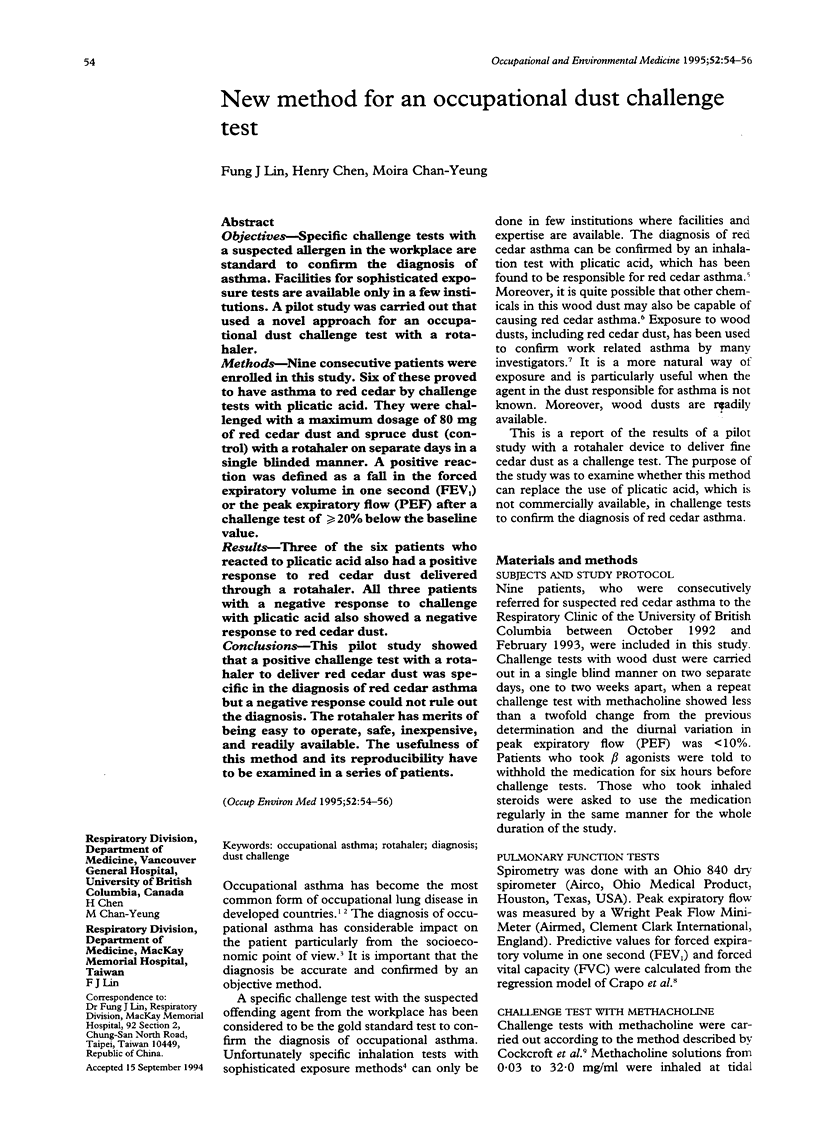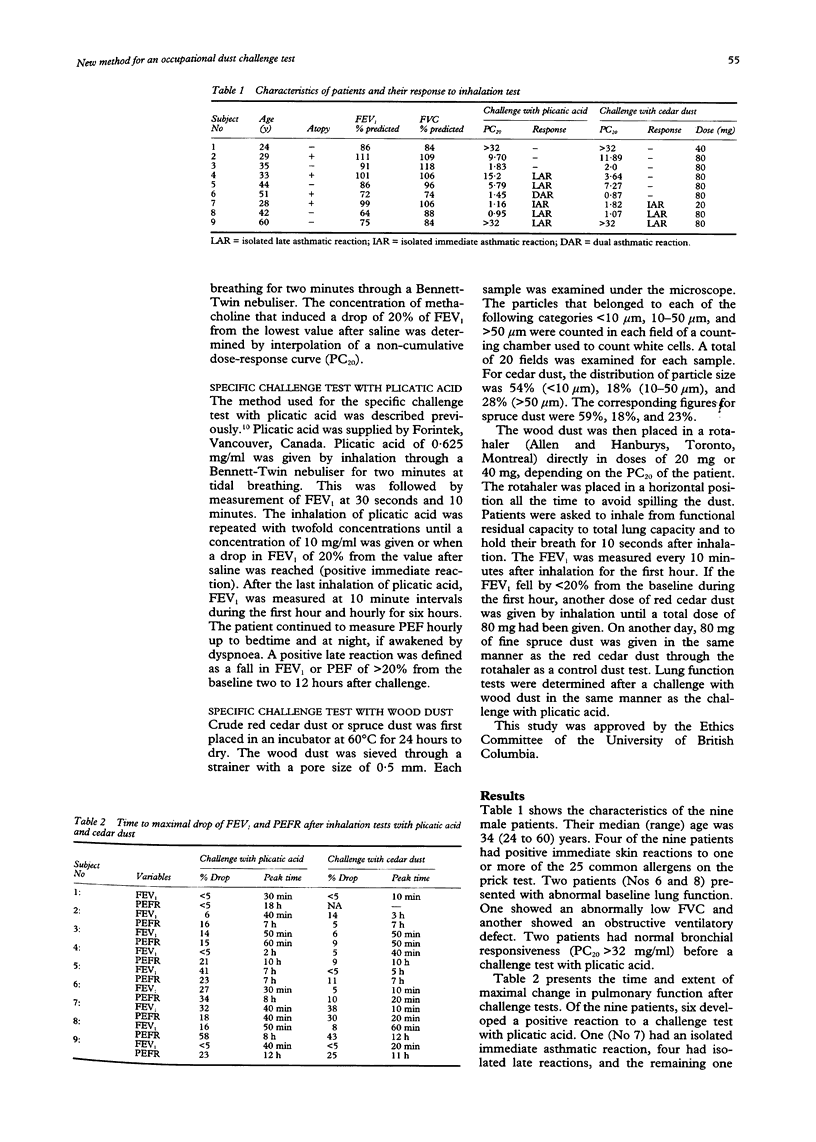Abstract
OBJECTIVES--Specific challenge tests with a suspected allergen in the workplace are standard to confirm the diagnosis of asthma. Facilities for sophisticated exposure tests are available only in a few institutions. A pilot study was carried out that used a novel approach for an occupational dust challenge test with a rotahaler. METHODS--Nine consecutive patients were enrolled in this study. Six of these proved to have asthma to red cedar by challenge tests with plicatic acid. They were challenged with a maximum dosage of 80 mg of red cedar dust and spruce dust (control) with a rotahaler on separate days in a single blinded manner. A positive reaction was defined as a fall in the forced expiratory volume in one second (FEV1) or the peak expiratory flow (PEF) after a challenge test of > or = 20% below the baseline value. RESULTS--Three of the six patients who reacted to plicatic acid also had a positive response to red cedar dust delivered through a rotahaler. All three patients with a negative response to challenge with plicatic acid also showed a negative response to red cedar dust. CONCLUSIONS--This pilot study showed that a positive challenge test with a rotahaler to deliver red cedar dust was specific in the diagnosis of red cedar asthma but a negative response could not rule out the diagnosis. The rotahaler has merits of being easy to operate, safe, inexpensive, and readily available. The usefulness of this method and its reproducibility have to be examined in a series of patients.
Full text
PDF


Selected References
These references are in PubMed. This may not be the complete list of references from this article.
- Blanc P. Occupational asthma in a national disability survey. Chest. 1987 Oct;92(4):613–617. doi: 10.1378/chest.92.4.613. [DOI] [PubMed] [Google Scholar]
- Boner A. L., Vallone G., Bennati D., Falagiani P., Gaburro D. Simplified spinhaler method for antigen-specific bronchoprovocation in children with bronchial asthma. I. Ann Allergy. 1986 Nov;57(5):363–366. [PubMed] [Google Scholar]
- Chan-Yeung M., Barton G. M., MacLean L., Grzybowski S. Occupational asthma and rhinitis due to Western red cedar (Thuja plicata). Am Rev Respir Dis. 1973 Nov;108(5):1094–1102. doi: 10.1164/arrd.1973.108.5.1094. [DOI] [PubMed] [Google Scholar]
- Chan-Yeung M., Lam S. Occupational asthma. Am Rev Respir Dis. 1986 Apr;133(4):686–703. doi: 10.1164/arrd.1986.133.4.686. [DOI] [PubMed] [Google Scholar]
- Chan-Yeung M., MacLean L., Paggiaro P. L. Follow-up study of 232 patients with occupational asthma caused by western red cedar (Thuja plicata). J Allergy Clin Immunol. 1987 May;79(5):792–796. doi: 10.1016/0091-6749(87)90212-0. [DOI] [PubMed] [Google Scholar]
- Cloutier Y., Lagier F., Lemieux R., Blais M. C., St-Arnaud C., Cartier A., Malo J. L. New methodology for specific inhalation challenges with occupational agents in powder form. Eur Respir J. 1989 Sep;2(8):769–777. [PubMed] [Google Scholar]
- Cockcroft D. W., Killian D. N., Mellon J. J., Hargreave F. E. Bronchial reactivity to inhaled histamine: a method and clinical survey. Clin Allergy. 1977 May;7(3):235–243. doi: 10.1111/j.1365-2222.1977.tb01448.x. [DOI] [PubMed] [Google Scholar]
- Crapo R. O., Morris A. H., Gardner R. M. Reference spirometric values using techniques and equipment that meet ATS recommendations. Am Rev Respir Dis. 1981 Jun;123(6):659–664. doi: 10.1164/arrd.1981.123.6.659. [DOI] [PubMed] [Google Scholar]
- Godnić-Cvar J., Gomzi M. Case report of occupational asthma due to palisander wood dust and bronchoprovocation challenge by inhalation of pure wood dust from a capsule. Am J Ind Med. 1990;18(5):541–545. doi: 10.1002/ajim.4700180504. [DOI] [PubMed] [Google Scholar]
- Marabini A., Dimich-Ward H., Kwan S. Y., Kennedy S. M., Waxler-Morrison N., Chan-Yeung M. Clinical and socioeconomic features of subjects with red cedar asthma. A follow-up study. Chest. 1993 Sep;104(3):821–824. doi: 10.1378/chest.104.3.821. [DOI] [PubMed] [Google Scholar]
- Orgel H. A., Meltzer E. O., Welch M. J., Kemp J. P. Inhaled albuterol powder for the treatment of asthma--a dose-response study. J Allergy Clin Immunol. 1985 Apr;75(4):468–471. doi: 10.1016/s0091-6749(85)80019-1. [DOI] [PubMed] [Google Scholar]
- Pepys J., Hutchcroft B. J. Bronchial provocation tests in etiologic diagnosis and analysis of asthma. Am Rev Respir Dis. 1975 Dec;112(6):829–859. doi: 10.1164/arrd.1975.112.6.829. [DOI] [PubMed] [Google Scholar]
- Vidgren M., Paronen P., Vidgren P., Vainio P., Nuutinen J. In vivo evaluation of the new multiple dose powder inhaler and the Rotahaler using the gamma scintigraphy. Acta Pharm Nord. 1990;2(1):3–10. [PubMed] [Google Scholar]


